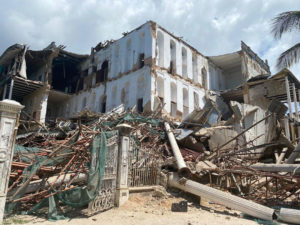by Paul Harrison
Red lights remain. Shifting to green from June?
Like so many countries, Tanzania continued to suffer the impacts of the global near-standstill of tourism traffic in the first quarter of 2021, as tourists from traditional markets were unable to travel due to second and third waves of COVID and resultant lockdowns. Tanzanian tourism operators have forecasted contractions in tourism of over 80%, according to a World Bank economic update on the country. An uncertain stance on the pandemic and fear of variants has led to Tanzania’s inclusion on red lists and travel warnings. However, as many countries progress vaccination programmes and the northern hemisphere summer approaches, the Tanzanian tourism industry has high expectations for a boost in numbers from June 2021. Many hotels and camps are already fully booked for the forthcoming high season; however tour operators are also experiencing last minute cancellations or delayed arrivals as pandemic-related restrictions change plans.
Red lists, regulations and repeat business
Despite rising bookings, the expected boost is not without risk. Whilst (at the time of publication) countries like the UK continue to red list Tanzania and the Centre for Disease Control in the USA ranks the country at the highest possible risk (advising against all travel), Tanzania seeks to highlight steps that it is taking to ensure that it is a safe destination. For some countries and their tourists, that will be more important than others. Continued focus lies on emerging markets like China and Russia which may be less affected by risk-averse government advisories.
Lodges and camps from beaches to the bush have had refits and refurbishments during the lockdown and companies are readying themselves for the return of business. Wildlife populations have noticed the relative quiet and are thriving in many parks, whilst the approaching migration-watching and mountain climbing seasons present a strong and timely offer. Newly-packaged destinations like Mafia Island, Nyerere National Park and Mpanga Kipengere Game Reserve (featuring Kimani Falls) are becoming better prepared to entice international and domestic tourists alike. However, for many tour companies, the spectre of regulations and taxes, seen as an increasing challenge in recent years, still looms. The industry will be watching carefully for any positive shifts in the investment climate.
Tourism industry players fear that raising park and concession fees in the Serengeti, Lake Manyara and Tarangire (effective from 1st July 2021) is a risky approach to take, especially as some neighbouring nations have cut park entrance prices and Tanzania is already seen as more expensive to visit than Kenya or South Africa. The opposing view is that for these high ticket value destinations in the prized Northern Circuit, relative to the full costs paid per tourist, the price rise is negligible. Either way, Tanzania will want to find a way to build up repeat business after The Citizen reported on findings that only twenty percent of tourists return to the country. Reasons given include high costs relative to services provided, infrastructure challenges and inconsistent quality and professionalism.
Pressures on Ngorongoro
In Ngorongoro, a public relations challenge, and potential human rights debate, is emerging. Some Maasai community members are concerned about eviction of communities from the conservation area as concern rises in other quarters that the human population living within the area has become too large. A debate ensues over which is the more impactful: the Maasai residents and their homes and livestock or the many camps, lodges, vehicles, tourists and support staff?
Keeping eyes peeled for poaching
The Tanzanian Government continues to pursue its antipoaching strategy, aware that as tourism numbers increase and the economy (global and national) rebounds, so too does the risk of a rise of poaching and trafficking. Enforcement, intelligence and ongoing support to community engagement, tackling human wildlife conflict and benefit sharing remain critical mitigation factors against an otherwise likely rise. Boosting tourism revenues again—and ensuring a proportion get back out to communities who had become dependent on them— will be critical, lest they don’t become disenfranchised as wildlife custodians.
Zanzibari misfortunes: Beit Al Ajab’s partial collapse and a major fire

Beit Al Ajab following the partial collapse in December. Emergency stabilisation works are now complete.
On Christmas Day 2020, Zanzibari residents and Omani and UNESCO partners were shocked by the partial collapse of the Beit Al Ajab, or House of Wonders, in Stone Town. An investigation followed as the building, which was completed in 1883, was undergoing rehabilitation and restoration work. The building is a significant draw to Zanzibar for tourism and authorities are keen to ensure that a thorough restoration takes place to bring the house back to its former glory. A severe fire that engulfed two five-star hotels in mid-January 2021 fortunately led to no fatalities. 338 tourists were confirmed safe after a fire in the Kiwengwa beach area, severely damaging both the Ocean Paradise and Tui Blue hotels. Nonetheless, Zanzibar has taken these misfortunes on its shoulders as it continues to seek new opportunities in different forms of tourism and linked marine conservation activities through a new blue economy policy.
